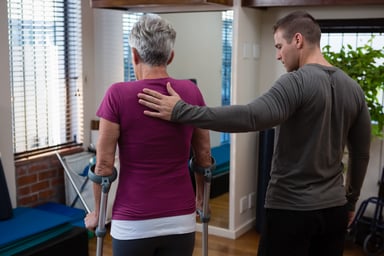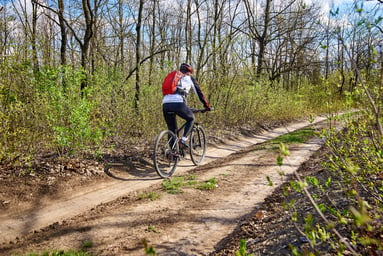What preventative screenings and tests are recommended for people over 50?
As we age, keeping our health on top form becomes increasingly important. Regular check-up...
Read moreHelping you to better understand health, life and protection insurance and live a healthier, happier life.
We're here to help you better understand health insurance, life insurance and protection cover.
Enjoy our top tips and advice to live a happier, healthier life and protect your future.
%20copy.jpg)
Everything you need to know about health insurance, from cover available to benefits. We explore the importance of protecting our health and common health insurance topics.

As we age, keeping our health on top form becomes increasingly important. Regular check-up...
Read more
There are a lot of things to consider when taking out private medical insurance. If it's n...
Read more
As we age, keeping our health on top form becomes increasingly important. Regular check-up...
Read more
In-patient and out-patient cover are a key part of a health insurance policy. Understandin...
Read more
Whether you’re new to health insurance, or you already have a policy and want to make the ...
Read more
Whether you’re new to health insurance and unsure where to start or want to change your po...
Read more
The NHS waiting list is estimated to have 7.5 million cases, highlighting just how straine...
Read more
In 2024, only 40% of adults reported going for a dental check-up every 6 months as recomme...
Read more
Cancer cover is one of the most valuable parts of a health insurance policy. Cancer change...
Read more
An estimated 6.2 million people in the UK had health insurance in 2023. 57% of people chos...
Read more
When it comes to health insurance in the UK, it's not always smooth sailing. While private...
Read more
If you’re new to health insurance, it can look confusing at first. With many different ins...
Read more
Heart conditions can be a significant concern for many individuals, especially as we age. ...
Read more
General practitioners are usually our first port of call for any illnesses or injuries we ...
Read more
The world of private healthcare insurance can be complex, and understanding the renewal pr...
Read more
As we spend more time in the sun this summer, it’s essential to be aware of the risks the ...
Read more
In the UK, private medical insurance (PMI) plays a crucial role in supplementing the servi...
Read more
In the UK, healthcare is primarily provided by the National Health Service (NHS), which of...
Read more
Preventive care plays a crucial role in maintaining good health and detecting potential he...
Read more
The UK is renowned globally for its comprehensive healthcare system, the NHS, which provid...
Read moreIf you're looking for clarity on the healthcare landscape in the UK, particularly the dist...
Read more
When it comes to navigating the intricacies of health insurance in the UK, it's crucial to...
Read more
With NHS waiting times higher than ever in 2024, it’s no wonder that many in the UK are op...
Read more
If you're looking for insights into optimising your health insurance coverage, you're in t...
Read more
A new report from the Office for National Statistics (ONS) and the NHS has found that wait...
Read more
The news of HRH The Princess of Wales receiving treatment for cancer, shook the nation thi...
Read more
We all know that every cigarette packs a punch of harmful chemicals, with each puff posing...
Read more
Lower back pain is a health concern which can occur at any age. It can significantly impac...
Read more
Getting the right health or life insurance is important. In the UK, there are many insuran...
Read more
In our golden years, the importance of health and wellbeing often comes into sharper focus...
Read more
When it comes to personal finance and financial planning, most people will spend most of t...
Read more
As the ageing population grows and the National Health Service (NHS) continues to face inc...
Read more
The question of health insurance becomes more pressing as we age, and being well-prepared ...
Read more
With the increasing strain on the National Health Service (NHS) and lengthening waiting ti...
Read more
If you’re looking into obtaining health insurance, you might be wondering if dental and op...
Read more
Few would disagree, we are privileged in this country to have access to free, lifesaving h...
Read more
Getting married is a significant lifetime milestone - so congratulations if you’re a beami...
Read more
Hip replacement is one of the most common elective surgical procedures in Britain; it has ...
Read more
If you’re thinking about getting covered with private medical insurance, there are a numbe...
Read more
If you’re looking to attract top talent to your business while also prioritising the physi...
Read more
The Royal College of Radiologists have found that cancer patients are facing worsening del...
Read more
The older you get, the more likely it is that you’ll need medical attention for an illness...
Read more
Having an ill child can be a stressful, emotionally challenging experience. This stress is...
Read more
NHS waiting times for major operations remain at a record-high, but now even access to a s...
Read more
While offering health insurance to your employees isn’t mandatory in the UK, it can noneth...
Read more
Walking has the power to completely reshape and rejuvenate your wellbeing. The simple act ...
Read more
Following the airing of ITV Tonight's latest episode: 'Buy Back Your Health? NHS vs Privat...
Read more
Offering private healthcare benefits to your employees is a great way to attract and retai...
Read more
Obtaining private health insurance is a great way to avoid surgery waiting times, obtain p...
Read more
If you’re looking to attract top talent to your small business, offering private health in...
Read more
If you’re thinking about getting covered with a health insurance plan, it’s helpful to und...
Read more
Having private health insurance is a great way to safeguard your future from unplanned and...
Read more
The right time to get cover Life can throw many curveballs and if COVID-19 is anything to ...
Read more
Overview of the Usay Compare service Usay Compare is a market leading comparison service f...
Read more
When it comes to buying Private Medical Insurance, not all brokers and intermediaries are ...
Read more
Private Medical Insurance is often dismissed by those who are not properly informed, as be...
Read more
Here at Usay Compare we are delighted that 4000 of our clients have taken to Trustpilot to...
Read more
If you think meditation is just for monks and hippies – or at least people with a lot more...
Read more
It’s one of the most common queries surrounding Health Insurance; why do I really need it?...
Read more
Is there anything more important in life than your health and wellbeing? Health Insurance ...
Read more
When purchasing a health insurance policy, there are various options and choices to make; ...
Read more
Health insurance policies can be tailored to fit your exact requirements; they are flexibl...
Read more
Health insurance is a blessing at the best of times, but with NHS waiting lists at a recor...
Read more
It’s easy enough for most people to understand the benefits of health insurance – especial...
Read more
Hip replacements have progressed significantly since 1891, when Professor Themistocles Glü...
Read more
According to Cancer Research, one in two people will be diagnosed with cancer in their lif...
Read more
It only takes a day of suffering with illness to bring sharp focus to the immeasurable val...
Read moreWe simplify life insurance, income protection and critical illness cover. Learn more about protection cover for you and your loved ones.

Life insurance can provide invaluable peace of mind and financial security. However, FT Ad...
Read more
The right time to get cover Life can throw many curveballs and if COVID-19 is anything to ...
Read more
The pandemic has caused many of us to rethink our financial security and Critical Illness ...
Read more
According to a survey carried out by independent consumer advice brand Which, just 9% of t...
Read more
Death, critical illness and lost earnings don’t exactly feature highly for the most pleasa...
Read more
The global pandemic may have been a wake up call for many of us. It has shown us there are...
Read moreEverything you need to know about health and well-being to support a healthier lifestyle. Dive into topics including fitness, exercise, cancer, and preventative care.

You may be surprised to learn that a staggering 48% of adults in the UK currently take vit...
Read more
Ageing is a gift - but going through the ageing process also means that you’re more likely...
Read more
As we age, keeping our health on top form becomes increasingly important. Regular check-up...
Read more
It is universally agreed that hydration is a vital contributor to healthy living. After al...
Read more
The spring season kicks off on 20th March and there is plenty for us to get excited for wh...
Read more
Achieving a healthy lifestyle can sometimes be a challenge. There’s a lot to consider in t...
Read more
In the cold months following the festive period, it can be hard to find the motivation to ...
Read more
Dry January is a well known annual campaign that encourages people to give up drinking alc...
Read more
2024 has been a year focused on health and well-being for us all. More people than ever ar...
Read more
Black Friday has grown in popularity over recent years in the UK, with Brits planning to s...
Read more
This week is Back Care Awareness Week, all about raising awareness for looking after our b...
Read more
As we head into the autumn season on Sunday 22nd September, there’s plenty to get excited ...
Read more
Summer has finally arrived! As we enter the new season, there’s plenty to get excited abou...
Read more
If I told you, it’s possible to live to 150, would you believe me? And if it was possible,...
Read more
In an era where the quest for holistic and non-invasive healthcare options is ever-increas...
Read more
Snoring is often dismissed as a minor annoyance or the subject of jokes within families an...
Read more
Smoking, and more recently vaping, are not just social or recreational activities - both o...
Read more
In today's fast-paced society, prioritising our health and wellbeing can sometimes take a ...
Read more
While we might not think about it often, our digestive system is one of the most important...
Read more
It’s fair to say that chiropractic care has something of a unique approach to wellness and...
Read more
Work is a big part of our lives. It can impact our physical health, mental health, and emo...
Read more
The older we get, the more our bodies undergo various changes, both physically and mentall...
Read more
Science has confirmed for decades that sleep is an integral part of our wellbeing, holding...
Read more
Whether it be the role of juggling family life and your career ambitions, or simply the st...
Read more
For many of us, the journey to a healthier version of oneself often involves the inquiry, ...
Read more
The golden years are an opportune time to invest in one's health, with exercise being a ke...
Read more
When it comes to ensuring optimal health in elderly individuals, nutrition takes centre st...
Read more
Ageing is a natural part of life, but it often brings along several health issues. Awarene...
Read more
Ageing is a natural and inevitable biological process, and going through the ageing proces...
Read more
Cycling offers the opportunity to keep fit and help with weight management, but the health...
Read more
Over 63% of adults are overweight or living with obesity in the UK. Unhealthy food choices...
Read more
Desk workers on average will spend 75% of their working day sat down and if you apply that...
Read more
The third leading cause of premature death in the UK is liver disease with a staggering 90...
Read more
Over-indulging on festive food has become common place over the Christmas period, with end...
Read more
You may be surprised to learn that lung cancer is the most common cause of cancer death in...
Read more
With Psoriasis awareness week in full swing now and running until the 4th of November, it ...
Read more
Happy Pancake Day! If you're like us and keen to celebrate Shrove Tuesday in style, but do...
Read more
November is Men’s Health Awareness Month and whilst we all witness the moustaches appearin...
Read more
As the last of the warm weather begins to subside and the nights begin to draw in, it can ...
Read more
Staying home during lockdown has kept millions of us safe from COVID-19 but has sparked a ...
Read more
One in three adults in the UK have high blood pressure and six million of those are comple...
Read more
It has been well documented and universally understood that coronavirus discriminates agai...
Read moreBuilding a healthy family can bring peace of mind. We explore topics such as childhood cancer, children’s mental health, stress management, and healthy ageing.

As a parent or guardian, observing sudden extreme fatigue in a child can be deeply concern...
Read more
A milk allergy is one of the most common food allergies in infants and young children in t...
Read more
Stress, a common phenomenon in our fast-paced modern world, is not exclusive to adults; ch...
Read more
When it comes to parenting, one of the most invaluable lessons we can bestow upon our youn...
Read more
Oral health is an integral part of our overall health and wellbeing, but this is particula...
Read more
Having an ill child can be a stressful, emotionally challenging experience. This stress is...
Read more
Since the early 1990s, incidence rates for cancers in children have increased by around a ...
Read moreHolistic health is about caring for all aspects of well‑being—mental, emotional, physical, social, and spiritual.

Over recent years, mindfulness has become a key topic in wellness. With an increase in men...
Read more
Stress can affect the lives of many, with 74% of UK adults reporting feeling stressed or u...
Read more
Looking after our muscle health and continuing strength training as we age can be an essen...
Read more
Want to live a longer life? A seven-year study from Vitality highlighted that Vitality mem...
Read more
Sleeptember is running throughout the entire month of September, dedicated to raising awar...
Read more
This month is National Pet Month and across our team we’re celebrating by sharing some cut...
Read moreWhether you’re looking for tips on managing stress, improving your mood, or learning more about mental well‑being, we’re here to support you.

Stress can affect the lives of many, with 74% of UK adults reporting feeling stressed or u...
Read more
Don't let your January be blue! We're sharing top tips to fight off the January blues and ...
Read more
Every November Men’s Mental Health Month is acknowledged in the UK. The aim of the month i...
Read more
This year’s Mental Health Awareness Week theme is “Moving more for our mental health.” Bei...
Read more
In an age where technology intersects with every facet of our lives, it's no surprise that...
Read more
May is dedicated to National Walking Month. As it gets a little warmer and the days are lo...
Read more
In today’s fast-paced world, stress has become an almost inescapable aspect of our lives. ...
Read more
Today more than ever, taking care of our emotional and mental health is as important as ta...
Read more
This week is Emotional Health Week, a time to stop and think about our emotional health, i...
Read more
Walking has the power to completely reshape and rejuvenate your wellbeing. The simple act ...
Read more
One in 5 people in the UK feel stressed more days a month than they don't. But why are we ...
Read more
Private mental health cover with top insurers such as Bupa, AXA, and Aviva, will enable yo...
Read more
If you think meditation is just for monks and hippies – or at least people with a lot more...
Read more
Over the last few years we've all faced stressful times, from the uncertainty and worry ca...
Read more
Social distancing, solitary confinement and the cancellation of events are a concerning co...
Read more